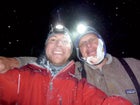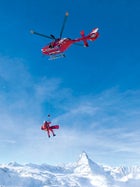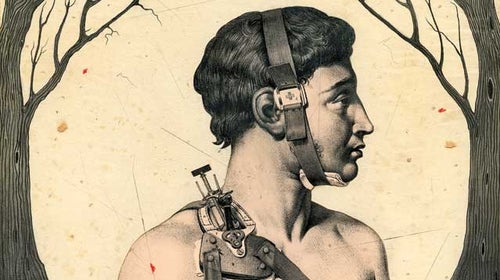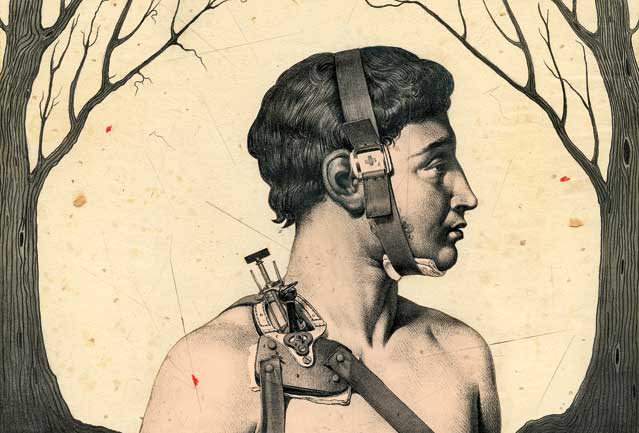ACCIDENTS HAPPEN. It’s the nature of nature, since chaos is built into the system. The trick is knowing the right thing to do when the wrong thing occurs. Which, for too many years, I didn’t.
Best Medicine
Five surprising tips that can save your life.Ice-climbing accident
 The author, right, after a falling-ice-block incident in Rocky Mountain National Park, Colorado
The author, right, after a falling-ice-block incident in Rocky Mountain National Park, ColoradoWoofer students
 Woofer students assess injuries in mock scenarios
Woofer students assess injuries in mock scenariosHelicopter evacuation
 Sometimes the only option: a helicopter evacuation at altitude
Sometimes the only option: a helicopter evacuation at altitudeMore than a decade ago, my brother Dan and I attempted to bike the length of Africa. We started at the top, in Morocco. Aside from puking up rotten dates and getting scrubbed too hard in a Marrakesh bathhouse, everything was going swell. South of Casablanca, we spent a night on one of the highest passes in the High Atlas Mountains, taking refuge in a tiny hut. The caretaker, a four-foot Berber, offered us shots of sweet mint tea. The only food was a jar of giant olives.
At one point, Dan had to take a leak and disappeared through the hut door into the darkness. When he didn’t come back, I started to wonder. Half an hour later, the Berber and I went for a look. Apparently, Dan had tried to walk around the back, but the hut was perched on a cliff. The Berber was swinging an oil lantern, and we were both staring over the edge when I heard Dan say, “Some brother’s keeper you are.” I climbed down the cliff; when I reached Dan, he was lying in the rocks with one mangled foot in the air.
“Broke my leg taking a piss,” he half-laughed, half-winced. We hauled him back to the hut and laid him out. I said, “This is going to hurt.”
“No shit, bro.”
I gave his foot a jerk, and he screamed and passed out. I straightened it but failed to splint it, so it was still floppy. Dan was in excruciating pain for a week before we got his lower leg put in a cast. Then we modified his bike pedals and continued riding through Africa.
Had I taken a wilderness medicine class, I would have known this: When you reset broken bones, you don’t yank. Instead, you pull, slowly and firmly, gradually allowing the bones to settle back into place. Then you splint the fracture, using whatever is at hand. A foam pad works well; sticks wrapped with a jacket will do.
Truth is, I should have taken a proper first-aid course 30 years ago. I guess I figured on picking up whatever I needed along the way, one expedition at a time. But after another trip to Africa during which chaos reigned—more on that in a moment—I decided it was irresponsible of me not to know exactly what to do in an emergency. So I coughed up $600 for one of the best training experiences in the country, the NOLS Wilderness First Responder course (nicknamed Woofer, a loose take on its acronym), and braced myself for ten straight days, nearly ten hours a day, of medical instruction.
WHEN THE CLASS CONVENES there are 30 of us, ranging in age from 18 to 57, and we’re all apprehensive as we gather for an orientation session in a lecture room on the University of Wyoming’s Laramie campus. The rigor and seriousness of this course are notorious, and a collective groan rises up from the students when two thick medical textbooks are handed out. Our instructors, Colorado ski guide Ryland Gardner, 48, and Wyoming wilderness expert Dusty Downey, 33, are experienced outdoor hands. They grin sadistically.
“By the end of this class,” Downey says, “you will know how to deal with everything from a tension pneumothorax to torsion of the testes.” (That’s a punctured lung and twisted nuts to you laymen.) Stout and direct, with sandy blond hair, Downey encourages us to view this course as preparation for emergencies in places where there are no lifesaving machines, the med kit is smaller than your sandwich, and “you are the doctor on call.”
Between lectures there will be five hands-on outdoor-emergency scenarios each day, plus two extended night scenarios. It’s winter in Wyoming, so all this acting will happen in the snow and wind. During each enactment, half the students will play the part of injured patients—complete with fake blood, fake broken bones, and fake vomit—and the other half will be first responders. We are urged to stay in character (plenty of screaming!) until the instructors call a halt. At the end of the ten days, there will be a written test and a half-hour practicum.
Between now and then, we’re expected to learn everything essential about backcountry first aid. And it’s a lot: how to bandage wounds, set fractures, stanch bleeding, perform CPR, treat hypoxia and hypothermia and hypoglycemia, recognize the difference between compensatory and decompensatory shock, recognize a broken back or a transient ischemic attack, and even remove a fishhook or a tick.
Which brings me back to Africa.
It was April 2007. I was deep in the Congo, and I had two dozen African ticks attached to my ass. This wouldn’t have happened if M’viri Bwily, my guide, hadn’t cleaved open his thumb with a machete one day. He came running to my tent, blood spurting everywhere. I had him sit down and raise his arm while I squeezed his thumb for 20 minutes. When the bleeding finally stopped, it was obvious he needed stitches, but M’viri would have none of it. Instead I fashioned butterfly bandages out of athletic tape and wrapped him up. (Had I already taken the Woofer course, I would have had Steri-Strips on hand, one of the best first-aid products for small-wound closure.)
M’viri could no longer accompany me into the jungle to track gorillas. If he had been with me, he would have told me not to sit where the gorillas had sat, because the beasts are infested with ticks. But I had told him to stay in camp, keeping his arm above his head. Jungles breed infection, and since we were days away from a bush clinic, I was afraid he might lose his thumb or his hand or his life if the wound became septic. So I gave him my only course of doxycycline, an antibiotic.
Then I started getting headaches and a stiff neck—which, unbeknownst to me, were classic symptoms of African tick bite fever. Lacking a good set of tweezers (another mistake), I squatted by the fire, digging them out with a pocketknife, a headlamp, and a mirror. But what I really needed—as I learned during a SAT-phone call to an African wildlife biologist in Brazzaville—was a round of (you guessed it) doxycycline.
In the end, M’viri and I both healed up, but it wasn’t pretty.
THE FIRST DAY OF CLASS begins at 8 a.m. sharp. Gardner, wry and fit, throws out a Mark Twain quote to set the tone: “One man alone can be pretty dumb sometimes, but for real bona fide stupidity, there ain’t nothing can beat teamwork.”
Then it starts, a whirlwind of medical knowledge imparted by Gardner and Downey, who tag-team a big range of topics: chest injuries, spine immobilization, neurological emergencies. After just an hour of lecture time, we’re thrown into the cold for our first scenario, a simulation of a high-altitude plane wreck. The injured are lying in the snow bellowing when we first responders arrive. We spread out and try to help.
Overwhelmed by all the fake blood, I kneel by my patient and try to stop the flow, failing to notice that she isn’t breathing. She dies because I didn’t clear her airway first.
Another first responder tries to move his patient before performing a thorough examination. Oops. The victim’s spinal column is severed and she dies.
Back in the classroom, we can laugh about what we did wrong, but we all feel enormous pressure to do the right things in the right order. Throughout the day, we continue to make critical mistakes.
In one field scenario, I’m so concerned about a broken leg that I fail to immobilize the victim’s head, which is fundamental. In another, I misread the patient’s behavior and leap to perform an abdominal thrust, only to learn that my subject was having an asthma attack and simply needed a puff on her inhaler. In yet another, I forget to ask a patient with a head injury if she lost consciousness, a sign of a possible concussion. In another, I fail to recognize the symptoms of shock.
By the end of the first day, one student speaks for all of us when she says, “I feel so stressed out by the initial scene, I’m afraid I’ll fuck it up.”
Gardner acknowledges that it’s easy to allow the urgency of the moment to make you move too fast and get it wrong. “You must force yourself to be calm, force yourself to slow down, force yourself to think clearly and logically,” he says.
In other words, don’t panic. But the only way not to panic is to practice not panicking. Which is precisely what we do during the remaining nine days, hour after hour, day after day. Gradually, we all become more relaxed, more competent, and more confident. Like emergency professionals, we stop hurrying. We take time to perform a thorough assessment of the person, the injury, and the environment.
MIDWAY THROUGH the course we have a day off. Some students go skiing, but a group of us get together to review, practice scenarios, and quiz each other. I’ve been studying every night after class, but I’m still anxious. We fire questions back and forth for hours:
Q: What are the earliest signs of high-altitude pulmonary edema?
A: Excessive fatigue, dry cough, shortness of breath.
Q: In CPR, what is the ratio of compressions to breaths?
A: Thirty compressions (at a rate of 100 per minute), then two breaths.
Q: What do the acronyms SOAP and LOR stand for?
A: SOAP—subjective, objective, assessment, plan. LOR—level of responsiveness.
Q: What is the treatment for an ice-ax puncture to the chest?
A: Plug the hole, cover with occlusive dressing, evacuate immediately.
The last one haunts me. I once took a 100-foot fall off a glacier on Shishapangma, an 8,000-meter peak in Tibet, and almost impaled myself with my ice ax. Another time, self-arresting while sliding at high speed down a couloir in Wyoming’s Medicine Bows, the ax pick popped off and the adze buried itself partially in my chest.
I always assumed that if I did really nail myself, even if I was days away from a hospital, I’d still live. But the Woofer has taught me otherwise. For some accidents, it doesn’t matter who you are or how tough you are: you’re still going to die. There’s no good treatment for a widespread disease that rangers in the Tetons call YMIS: young man’s immortality syndrome. But taking a Woofer, and learning just how easy it is to kill yourself, ain’t a bad start.
THE MOST COMMON backcountry injury is not something dramatic like impalement or grizzly mauling or snakebite. Instead, it’s an ordinary sprained ankle. Makes sense: Who hasn’t tripped and twisted one? The treatment: taping. The NOLS course teaches a bombproof tape job that I really could’ve used the 17 times I sprained one of mine.
The Woofer also prepares you to deal with a catalog of less common but far more interesting outdoor emergencies, some of which overlap with my own experiences.
Like the time my three brothers and I were cleverly mountain-biking in Moab during the dog days of summer—approximately 163 degrees out—and my brother Steve disappeared. We found him naked, hiding under a thornbush, mumbling bizarrely, pouring the last of his water on his genitals.
Did he have heatstroke, which can be fatal, or heat exhaustion? Probably exertional heatstroke, judging by his altered level of responsiveness. Of course, we had no idea at the time, so we sprayed him with water and forced him to drink. Luckily, he recovered.
Or the year I was coming off Denali and met a French couple trudging to the summit. She was being short-roped up, practically dragged, and her cheeks and nose were white. Without asking, I put my bare hands on her face and explained that she was getting frostbite. She was confused. Although it might not have been my place, I told the couple they were moving too slowly and should turn around.
Her partner cursed at me, and they continued on. Ten hours later, a full-scale rescue was initiated. The woman was eventually dragged down the mountain in a sleeping bag, with frostbite not only on her face but along one whole side of her body.
Or the year I climbed Mount Kenya and met four plumbers from London at Mackinder’s Hut, one of whom had acute mountain sickness. He was a giant of a man, had a skull-bursting headache, a rapid pulse, and rapid respiration, and was puking and slightly ataxic. I told the Brits they needed to get their buddy to a lower elevation immediately. They were offended. This was their expedition—they’d been planning it for years. In 48 hours, they’d gone from sea level to 14,000 feet, and no smart-ass Yank was going to stop them. Fair enough. I went on up to the Austrian Hut.
Three a.m., there’s banging on my door. It’s the plumbers. Their buddy is now unconscious. He has shit and pissed himself and is covered with puke, and his breathing is deeply labored. Borrowing porters from a half-dozen other teams, we organize a rescue. Carrying the giant in a litter, we get him to the bus stop at 10,000 feet, where, without a word of thanks, the three plumbers abandon him and head back up the mountain—which, karmically, they fail to summit.
THE WOOFER, or an equivalent course, is what most mountain guides, river guides, ski patrollers, and recreation-program managers are required to take. But it’s also perfect for those of us who spend a lot of time in the backcountry. We learn how to take vital signs—pulse, blood pressure, respiration rate, temperature—and what these numbers mean. We’re taught how to splint dislocated fingers and broken toes, how to build a traction splint for a femur break, how to immobilize a patient in a litter, even how to give a saline injection. Personally, the most valuable skill I learn in Woofer is how to perform a focused spine assessment.
I don’t think I’ve had a serious climbing or skiing or kayaking partner who hasn’t taken a bad fall at some point—hitting his head, smacking her back, whacking a tree, thumping a rock, and inevitably breaking something. Arms and legs are one thing, but injury to the back or neck is delicate: misdiagnose the situation in the field and the spinal cord may subsequently be severed, causing paralysis or death. In a focused spine assessment, which is performed only after a patient assessment, there are five clear steps to follow that can accurately tell you whether the patient will need to be backboarded and carried out or whether he can walk out on his own.
Two years ago, I was caught in an avalanche while ice climbing. My partner was swept off the ice, and when I got down to him, he was hanging by the rope, upside down. I cut him free and laid him in the snow and did everything I could think of. Had I known how to perform a focused spine assessment, I would have known that my partner had broken his neck severely and there was nothing I could do to save him. As it was, I was almost out of my mind with anxiety.
Near the end of the Woofer course, we’re sent out on a four-hour night scenario up in the mountains. At 8,000 feet, the wind is whipping so hard it seems to be throwing the stars around. We are divided into teams of five and sent out into the snowy forest, tromping through knee-deep drifts. The moon is a sliver playing hide-and-seek. Our headlamps bob on our heads like luminescent butterflies.
For some reason, I’m thinking about Downey’s lesson on how to use an EpiPen, an injection of epinephrine to counteract life-threatening anaphylactic shock. “Don’t be afraid,” he insisted, “just stab it right into their thigh. In some situations it’s the only thing that will save them. And nothing—nothing—is more important than saving a person’s life.”
His voiced cracked when he said this, and I could tell that he had a story he wasn’t going to share. Now, postholing through the crusty blue snow beneath the stars, it occurs to me that this, in a nutshell, is the entire point of the Woofer class: to acquire the skills to save a human.
After an hour of hiking in the snow in the dark, my team hears shouting and we begin plunging down through the trees.
We find our victim at the base of a small cliff. He has fallen. He’s screaming in pain. There’s blood in the blowing snow. Did he break his back? Break a leg? Puncture a lung? Hit his head?
Doesn’t matter. We know what to do.

